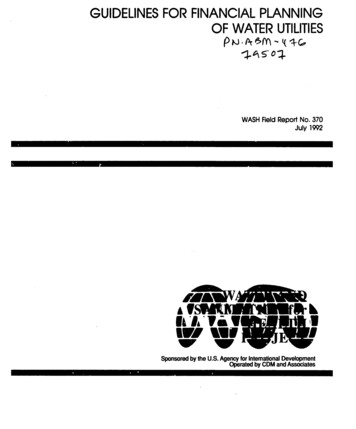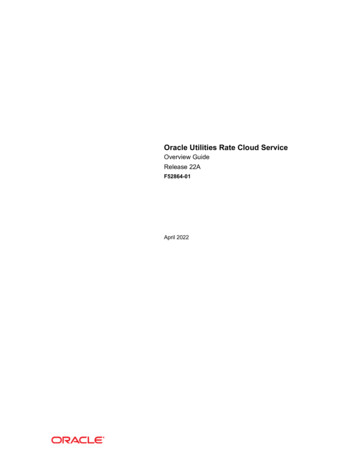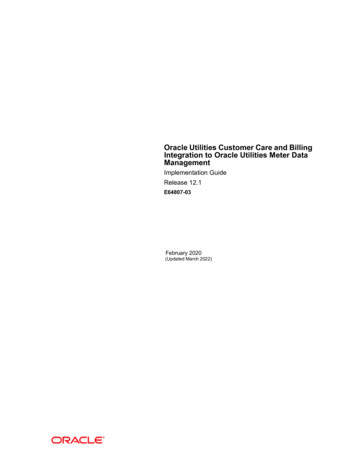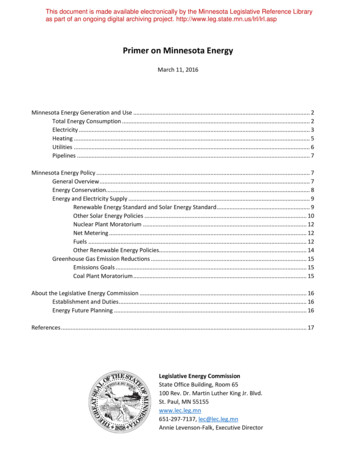
Transcription
GUIDELINES FOR FINANCIAL PLANNINGOF WATER UTILITIESWASH Field Report No. 370July 1992Sponsored by the U.S. Agency for Intemational DevelopmentOperated by CDM and Associates
WASH Field Report No. 370GUIDELINES FOR FINANCIAL PLANNIN(OF WATER UTILITIESPrepared for the Office of Health,Bureau for Research and Development,U.S. Agency for International Developmentunder WASH Task No. 070byStephen V. PereiraJuly 1992Water and Sanitation for Health ProjectContract No. DPE-5973-Z-00-01-00, Project No. 936-5973ia apomored by the Office of Health, Bureau for Re earch and DevelopmentU.S. Agency for International DevelopmentWaahditon, DC 20523
WASH FINANCIAL MANAGEMENT SERIESThe Water and Sanitation for Health (WASH) Project has developed a series of publicationsdealing with financial management and cost recovery issues. Currently there are four reportsIn this series. Titles of these publications are as follows:Report 1Guidelines for Conducting a Financial Management Assessment of WaterAuthorities (WASH Technical Report No. 53)Report 2Guidelines for Cost Management in Water and Sanitation institutions(WASH Technical Report No. 54)Report 3Principles of Tariff Design for Water and Wastewater Services (WASH FieldReport No. 348)Report 4Guidelines for Financial Planning of Water Utilities (WASH Field Report No.370)The four reports provide an integrated package of financial and management assistance andhave been prepared for audiences at varying skill levels within the financial discipline, at boththe operational and the administrative levels. The approach of the reports is directive. Thereports can be used individually or together. Report 1is an assessment and diagnostic tool andwould logically be the first report used to appraise the current financial management situationof a water supply Institution. Weaknesses identified in the initial assessment of such areas ascost management, tariff policy, and financial planning can be addressed by using the otherWASH reports in the series.
CONTENTSABOUT THE AUTHOR .EXECUTIVE SUMMARY .1. INSTRUCTIONS .1.11.2How to Use These Guidelines .Overview of the Financial Forecasting and Planning Process .1.2.1Determining Objectives .1.2.2Developing a Plan .vvii112242. FORECASTING CONSUMER DEMAND .73. DEVELOPING A CAPITAL INVESTMENT PLAN .93.13.2Overview .Costs to Be Included in the Capital Investment Plan .3.2.1Repair and Rehabilitation .3.2.2Replacement versus New Capital Assets .4. EVALUATING REVENUE REQUIREMENTS AND REVENUE SOURCES .4.14.24.34.4Overview .Forecasting Water Sales to Metered Customers .Forecasting Unmetered Sales .Applying the Rate Schedules .5. ESTIMATING EXISTING AND PROPOSED OPERATION ANDMAINTENANCE COSTS .5.15.25.399910151515161619Overview .19The Use of Historical Data .19Planning Source of Supply, Pumping, Water Treatment, Transmission, andDistribution Expenses .205.3.1Labor .205.3.2Materials and Supplies .201
.15.5.25.5.35.5.45.5.5Fuel and Power .Chemicals .Customer Accounts and Service Expenses .Labor, Materials, and Supplies .Customer Billings for Work Performed .Uncollectible Utility Revenues .Administrative and General Expenses .Employee Pensions .Transportation .Wages and Salaries .Operating and Maintaining Equipment .Materials and Supplies .2021212122222222222223236. PLANNING CURRENT AND RESTRICTED ASSETS .27Overview .Liquid Assets .Materials and Supplies .Restricted Assets .272729306.16.26.36.47. PLANNING LIABILITIES .7.17.27.37.4Overview .Current and Accrued Liabilities .Long-Term Liabilities and Equity .The Cost of Financing .Long-Term Debt .7.4.1Depreciation .7.4.2Capital Recovery Charges .7.4.3Contributions .7.4.4333333343434353535APPENDIXA. FINANCIAL AND OPERATIONAL LEVERAGE .37FIGURES1. System of Water Utility Objectives .2. Sample Financial Objectives by Finance Area .II23
5.6.7.8.Illustration of an Annual Operating Budget Structure of a Water Utility .Illustration of Some Components of Operation and Maintenance Expenses .Cash Flow Forecast for the Year FY.Worksheet for Statement of Changes in Assets Restricted for Long-TermDebt Service .inI24263132
ABOUT THE AUTHORStephen Pereira is an International Management and Finance Specialist with the ResearchTriangle Institute (RTI). He specializes in financial analysis of local governments, particularlytheir capacity to undertake capital investment programs, with special emphasis on costrecovery, revenue generation potential, and debt carrying capacity. He has worked extensivelyIn Indonesia, Nepal, and El Salvador, where he developed financial appraisal methodologies,in addition to cost recovery and betterment levies work for the World Bank in Colombia,Bolivia, and Mexico.v
EXECUTIVE SUMMARYThe purpose of this report is to provide a comprehensive overview of a financial planningprocess that a water utility can use to determine its short- and long-term financing strategies.The goal of sound financial management isto allow a utility to achieve the highest amount ofoutput possible for a given amount of input.Successful financial planning for a water utility Involves anticipating the needs and futuredemand of the community being served, designing facilities to meet demand, minimizing thecosts of operation, constructing and/or purchasing fixed assets for the utility's expansion orrehabilitation, replacing or retiring assets in a timely way, and developing and implementingfinancing mechanisms to fund these activities. Designing a financial plan requires identifyingand evaluating the factors that affect the type and size of the utility's facilities, the financingmechanisms available, and the potential cost recovery from prospective beneficiaries of theservice.This paper provides a series of six steps to assist the user in developing a comprehensivefinancial plan.The first step in establishing a workable financial plan is to determine consumer demand.Projection of growth in consumer demand isessential to devising the capital investment plan,which isthe next stage in the financial planning process. Designing the capital investment planis one of the most important components inthe successful planning of a water utility, and isessential for securing appropriate financing. The plan establishes priorities for individualprojects and schedules them for funding over a five- or six-year period.After developing the capital investment plan, In step three, plan managers must comparerevenue sources with revenue requirements for the five- or six-year planning horizon. Clearly,revenue requirements must match revenue sources to maximize smooth operations andminimize changes Incharges to customers. In order to fully identify all costs of the utility, stepfour addresses the estimation of the utility's existing and proposed operation and maintenancecosts. At this stage management will need to identify increased operating costs associated withnew facilities as well as proposed operating costs of existing facilities.Step five in developing a sound financial plan concerns planning cash flow and net workingcapital. A water utility's cash flow varies yearly, quarterly, and even weekly depending on itsoperational policies and the changing economic and business environment. Therefore, constantreview and updating of working capital are necessary. The final step, step six, is planning forcurrent, accrued, and long-term liabilities. Liabilities represent a water utility's various debtobligations, including payments to suppliers, notes on short-term borrowing, and long-termdebt.A number of sample spreadsheets and flow charts are provided in the report to facilitate thefinancial planning exercise. Their use requires some ability in financial analysis and exposureto utility management on the reader's part. The report concludes with an appendix thatvil
includes afully costed example of how a water utility might go about planning what level ofleveraging is best to target, given a known set of income sour-Is. Two sets of data arepresented. In the first case autility may choose to finance activities using Its own resources,rather than incur any debt. The second case depicts a utility that chooses to finance itsactivities by borrowing as much as lenders will allow while investing only a small amount ofIts own funds.vi
Chapter 1INSTRUCTIONSWater utilities generally bear two different types of expenses. The first type, called recurrentcosts or operatingcosts, includes such items as the cost of electricity, salaries, and chemicals.The second type, capital costs, includes building and equipment purchases, debt service,reserve fund contributions, and the costs of supply, treatment, transmission, and distributionof potable water to customers.Recurrent costs are usually less expensive, on an tem-by-item basis, than capital costs, andthey must be paid anew each year. Capital costs, on the other hand, are usually expensiveper item, and occur irregularly as the utility acquires assets. Because capital assets (e.g.,buildings and equipment) last a long time, decisions about capital expenditures also have long term consequences. A mistake in a major capital outlay decision usually is irreversible for theentire useful life of the asset.The long-range consequences of capital cost decisions mean that special financial and capitalplanning are very important for water-utilities, hence the reason for this paper. Water utilityfacilities constructed without the benefit of -comprehensive planning lead to inefficientexpenditures and inefficient services to the community. As a result, unplanned water systemspose a burden to all prospective beneficiaries-citizens, government, and commercial,residential, and industrial clients.Financial planning means anticipating the needs and future demand of the community beingserved, designing facilities to meet demand, minimizing costs, constructing and/or purchasingfixed assets for expansion or rehabilitation, replacing or retiring assets in a timely way, anddeveloping and implementing the financing mechanisms to fund all of these activities. Properplanning allows a utility to achieve the highest amount of output possible for a given amountof input.These guidelines provide a comprehensive overview of a financial planning process that awater utility management team can use to determine short-term and long-term financingstrategies.1.1How to Use These Guidelines" Section 1.2 gives an overview of the planning process and discusses its majorcomponents. Included are the six steps involved in developing a financial plan. Theorganization of this report is based on these steps, as follows:* Chapter 2 examines forecasting consumer demand for water and services.I
"Chapter 3 describes how to develop a capital investment plan, including the differentcapital projects and outlays that form the basis of capital investments.* Chapter 4 reviews how to evaluate revenue requirements and revenue sources." Chapter 5 covers estimating existing and proposed operation and maintenance costs." Chapter 6 describes planning as it relates to current (liquid) and restricted assets.* Chapter 7 examines liabilities planning." Additionally Appendix A provides a technical overview of financial and operationalleverage. Its use, as well as that of various tables and formulas in the report, requiressome ability in financial analysis and exposure to utility management on the reader'spart.1.2Overview of the Financial Forecasting and Planning Process1.2.1Determining ObjectivesFinancial planning is only one of a water utility's overall objectives, as shown in Figure 1. Theother three components of the overall objectives are customer demand, capital- investment,and human resources. Only Ifthe planning objectives of each component are achieved will theoverall planning objectives be met.Figure 1SYSTEM OF WATER UTILITY OBJECTIVESUilit 0bjeVeshtetua11Rw nW*Customer demand. Probably the single most important factor that influences financialplanning is capital expansion due to growth in demand. Customer demand planningincludes forecasts for each segment of usage per customer category (residential,commercial, industrial, etc.) and the geographical distribution of these customers. A long term forecast of water service customers allows water utility managers to anticipate2
requirements for plant facilities and select and design facilities to meet those requirements.It also helps managers to time capital expenditures to ensure adequate plant capacity tomeet demand, and develop and implement long-term plans to finance such activities."Capital investment. Planning the capital expenditures of a utility is one of its mostimportant management considerations. This type of planning comprises anticipating theneeds of customers for water service, selecting and designing the proper plant facilities tomeet these needs, purchasing or constructing required additions to the plant on time,replacing and retiring plant assets, and securing funds for plant investment." Human resources. Human resource planning and development can be done oncecustomer demand and capital investment plans are determined. While not the focus of thepresent study, personnel inventory, salary curve, and other factors critical to this areawarrant consideration.*Rnanclal planning. Specific financial planning objectives-such asthose in Figure 2-alongwith the other three component's objectives, feed into the overall financial planningprocess.Figure 2SAMPLE FINANCIAL OBJECTIVES BY FINANCE AREAFinancialAreaObjeciveReturnsCover costs and contribute to capitalreplacement and expansion.Borrowing PolicyMaintain a balance between borrowingand current receipts to finance newcapital needs. Borrow for capital needsup to a limit specified by sound financialmanagement practices.Credit and CollectionMaximize billing and collectionefficiency and minimize losses.Depreciation PolicyAccount for physical depreciation andreplacement costs.LiquidityMaintain an acceptable level of workingcapital.3
1.2.2Developing a PlanDeveloping a water utility financial plan requires Identifying and evaluating those factors thataffect the type and size of facilities, the financing mechanisms available, and the potential costrecovery from prospective beneficiaries of the service. Typically the time period for an accuratefinancial plan should extend no more than five or six years.N Step 1: Determining consumer demand. As mentioned in Section 1.2.1, one of the mostImportant factors affecting financial planning is growth in consumer demand. Historical data,such as per capita consumption, should be examined to ensure that underlying conditionshave not changed. The impact of changing economic and social conditions on the number ofcustomers within a particular category, the quantity of water sold within each block, and otherfactors affecting customer demand must be evaluated. Projections of historical trends must beadjusted to account for changing conditions in the service area. Specifically, the number ofcustomers serviced should be adjusted for changes in demographic profile, the number ofbuilding permits issued, the number of houses built, and so on.Customer demand forecasts are used to determine the capital investment plan, the next stagein the financial planning process.0 Step 2: Developing the capital investment plan. The capital investment plan establishespriorities for individual projects and schedules them for funding and mplementation. The five or six-year forecast period encompassed in the capital investment program ensures that capitalrequirements are ahead of actual needs. The capital investment plan is essential for securingappropriate financing.Capital expenditures will consist of payments for existing debt service, reserves, and routinecapital projects financed from annual income. Additionally, depreciation based on utility plantinvestment, and estimated service lives, should be accounted for.E Step 3: Evaluating revenue requirements and revenue sources. After the capitalinvestment pian Is developed, the next step is to compare all utility revenue sources withrevenue that will be required during the five-year planning period. This comparison is doneto minimize the effect of securing income on utility finances and charges to customers.Projections of revenues for periods longer than five years are highly speculative. Successfulfinancial planning requires that the capital investment plan have a demonstrated effect onrevenue and revenue requirements for the planning period.During this step, the utility will need to identify and assess (a) new revenue requirements,including the associated costs of each financing alternative; (b)existing financing requirements;and (c) operation and maintenance costs of existing and proposed expansion activities.Based on billing records, customer accounts are developed by customer class for the five-yearplanning period. Large users are listed separately to minimize their impact on the average useper customer. Customer account projections are based on multiyear trends rather than on themost recent year of historical information, the recent number of building permits used, or a4
design engineer's estimate of use. Large deviations from historical trends (such as thoseresulting from the expansion of services) need to be taken into account.Projections of water-sales revenues should be based on the projections of the number ofcustomers and water sales developed concurrently for the financial plan. The number ofcustomers served, the amount of water used per block, and the existing schedule of watercharges by customer class projected for each year of the planning period should providrealistic projections of water sales.Recurring nonoperational revenues should also be evaluated for the planning period. Arealistic level of income based on past historical trends should be estimated for these revenues.H Step 4: Estimating existing and proposed operation and maintenance costs. This stepaddresses the operation and maintenance (O&M) costs associated with existing and proposedwater utility operations. Some of the O&M costs that can be identified in water utilities aresource of supply, pumping, watertreatment, transmission and distribution, administrative costs,and general costs.A review of past records should indicate long-term trends and a basis for projecting costs. Atthe same time, management should determine whether the historical series will exist into thefuture. Regardless of how costs are projected, allowances should be made for the long-termeffects of inflation.The utility will also need to identify increased operating costs associated with new facilities aswell as the proposed operating costs of existing facilities.N Step 5: Planning l!quid and restricted assets. This step concerns planning cash flow andthe net working capital of a water utility. It is important to maintain adequate receipts andrecords of cash disbursements, to determine possible future deficiencies and short-termfinancing needs, and to plan for extra liquidity that could originate from monthly transactions.For instance, excess cash held in checking accounts is a noneaming asset and could be putto more profitable use (such as paying interest debt).Cash flow varies weekly, quarterly, and yearly depending on management's operationalpolicies and changing conditions in the economic and business environment. Given thesechanges, review and constant updates are essential if estimates are to be useful for financialplanning.Cash receipts and disbursements are estimated based on historical performance andtendencies. They must be adjusted for differences on a cash or accrual basis. This adjustmentwill depend on daily operations, cash disbursements for capital investment projects (dependingon whether they are paid from special funds), cash inflows and outflows from customerdeposits, receivables, and materials and supplies.N Step 6: Planning liabilities. Current and accrued liabilities are those that finance the assetsand operations of a water utility. The planning of these elements begins with the formulation5
of the operating budget based on historical levels, costs of materials and supplies, and thecapital budget.Long-term liabilities are long-term debt used to finance the capital investment plan. This debtdoes not exclude buildup of equity, as financial planning requires various sources of financing,with equity as one alternative. Other sources include short-term debt, retained earning (whereavailable), financing through bonds, and so on.6
Chapter 2FORECASTING CONSUMER DEMANDForecasting the demand for water is a key ingredient of the financial planning process. A long range forecast of the demand for water is necessary to ensure that the determined capacity isadequate but not substantially more than that required to meet peak and future demand. Along-term forecast of a community's annual requirements for water service will enable thewater utility to plan for plant facilities, to select and design facilities to meet demand, and toundertake capital investments over time through long-range financing. If forecasting is to bean effective financial planning tool, it must project the level of demand for the next five years.However, an extended period of time, usually 20 to 30 years, is the preferred planninghorizon of a master plan for consumer demand.Changes in economic and social conditions in a water utility's service area can alter thenumber of customers in a given tariff block, the quantity of water sold within each block, thenumber of metered connections, or the number or size of meters. Therefore, as part of theforecasting process, historical data-such as per capita consumption records-must be-examinedto ensure that underlying conditions in the external environment have not changed.Specifically, the estimated number of customers based on projection of historical trends shouldaccount for changes in population, which may affect the number of building permits issued,or the number of new houses built, for example. Likewise, historically based projections of thequantity of water sold should be adjusted for estimated effects of changes in pricing policies,as well as other general and local socioeconomic conditions.7
Chapter 3DEVELOPING A CAPITAL INVESTMENT PLAN3.1OverviewCapital investment plans are needed because capital investments or outlays are expensive, donot occur annually, and have long-lasting consequences.The overall capital investment plan is supported by individual budgets for new andreplacement projects. Each project budget includes a description of the project, a projectnumber, an explanation of the project's purpose and need, an implementation schedule,engineering cost estimates, estimated incremental operations and maintenance costs, and aninternal rate of return on the project (where applicable).Consistent with the long-term forecast of consumer demand for water, the capital investmentplan should reflect short-, medium-, and long-term needs, although the cost estimates forshort-term components will be more precise than those for long-term improvements andexpansions.A capital investment plan divided into five-year increments over a given planning horizonfacilitates the use of other financial management tools, such as capital budgeting.3.2Costs to Be Included In the Capital Investment PlanCapital investment projects can be classified into two categories: major and blanket projects.Majorprojectsare those that cost a considerable sum relative to ongoing operations. Examplesare projects related to source of supply, pumping, water treatment, transmission anddistribution facilities, and equipment. Blanket projects include proposed additions to andretirement of customer services, meters, and hydrants. Both types should be included in theinvestment plan.In some cases, planners may have difficulty determining whether to add certain capitalinvestments or expenditures to the capital investment plan. Such investments may be repairand rehabilitation projects, or replacements as opposed to new capit?' 3ssets and equipmentpurchases.3.2.1Repair and RehabilitationWater utilities often repair, rehabilitate, or renew existing facilities. It is common, for example,to rebuild existing pumps to extend their useful service life for several years. Generally, if aproject adds value to a facility, it is by definition a capital item. However, because it may notbe practical to determine for each project whether value has been added to the plant, amonetary cutoff value is often used. Projects costing more than the cutoff amount are9PreiZ
considered to add value and so are Included in the capital investment plan. The cutoff amountvaries depending on the size and budget of the water utility.A similar criterion is often used with equipment purchases. If a purchased unit (for example,replacement pumps for a water treatment plant) can be absorbed into the operating budget,it need not be placed in the capital plan. (This criterion varies by country and by size of waterutility.) Also, if the equipment purchase occurs on a recurring basis, even though thepurchase price may be above the cutoff point, those expenses can be excluded from thecapital investment program. The operating budget is oriented to handle such costs that occurannually. Thus, if the cost of a specific piece of equipment is relatively high and the item isnot purchased or replaced each year, it should be included in the capital investment program.3.2.2Replacement versus New Capital AssetsPlanners sometimes distinguish between capital outlays used to replace existing capital facilitiesand equipment, and outlays that are used to acquire new facilities and equipment. Newoutlays occur when a new service is started or an existing one is expanded.Because replacements demand important cost decisions, they are deemed to be as importantto the investment plan as additions. For this reason, if they are costly and do not occurannually, replacements should be included along with new purchases in the capital investmentplan. For example, if a new treatment plant is added to an existing one, it is considered a newfacility, not a replacement.Figure 3 presents a sample summary of a five-year capital investment plan.10
Figure 3SAMPLE 5-YEAR CAPITAL INVESTMENT PLAN SUMMARYFYto FYFI z WProj.No.idiameProject Dcsiptjonsmlea307ortsExpenditureor Rtirentsw of EndFYREpenditureOrRtmeRequre toCompleteBudgeted Expenitures or RetirementsFY Iof Sopidy PiatPurcimae of RaervoirLad Expndirm306Roadway Extntios onReservoir309Repiemaot of Bridgesmad Culverts310Coadnwtioaof WellstoTotal Expmd&ur313Supply Plat SouroeTotl RetiremetSupply Pua SourcesPeidne Phd314New Pumping Station315Pumping Staion:ExpediursRetirementaToed ExpendituresPumpin PlaTotal Retir mntsPumpig Plat316to321Water Treatment Plant.TotalRetircaimei-WaserTreatment Plant11FY2FY3FY4FY5
Figure 3 continuedPa.No.RaimalodP.eLrevnenor peiditrProject DefImEzpcudhaoBudgeted EpmuWiwor Residrnmtw of EndFYRedremeataRequired toCompietFY ITramldom andDbtrlbotioe Pbult322New Ditributia Tnk323LwacpiIng324Extmeion do---Replaememt of ger iuooDaW bveadkrm DW.N.Plw12FY 2oratiimbmFY 3FY 4FY 5
Figure 3 continuedProj.No.Proct DowuiptionTotaRdkcruaits-EsiawHipandiwreor Retirmmtsor Reeiraemabm otf dFYRatirumrbRequirodbtoCoampleFY IFY 2PY 3------PY 4PY S--Trwamjioa androDitbuio PlantTota!- - - - -- - - - -- - --- - - - -- - - - -. . . .EWWmduzrs-WuterUtility PlanT1otaReireami-WwtrUtility PIan13
Chapter 4EVALUATING REVENUE REQUIREMENTS AND REVENUE SOURCES4.1OverviewSound planning is a prerequisite to obtaining an adequate level of revenue. Total operatingrevenues must be sufficient both to enable the water utility to provide adequate service andto ensure the maintenance, development, and sustainment of the system.The first step in evaluating revenue requirements is to estimate the revenue component of thebudget. Operating revenues are a function of the demand for water service. This demand inturn is a function of factors such as the area's population, industrial concentration, weatherconditions, and the customs of the people using the water, whether for sanitary or otherpurposes.Operating revenue forecasts can be prepared in two steps:1. Estimate the quantity of water required by
Determining Objectives Financial planning is only one of a water utility's overall objectives, as shown in Figure 1. The other three components of the overall objectives are customer demand, capital-investment, and human resources. Only Ifthe planning objectives of each component are achieved will the overall planning objectives be met.











